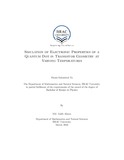Simulation of electronic properties of a quantum dot in transistor geometry at varying temperatures

View/Open
Date
2016-03Publisher
BRAC UniversityAuthor
Ahsan, Md. GalibMetadata
Show full item recordAbstract
Electrical conduction is the
ow of electron due to a force applied by an
electric eld. In bulk material, conduction process obeys Ohm's law. The
law states that current is proportional to applied voltage. But nano-sized objects
behave di erently. At these range quantum e ects modify the electronic
conduction properties and exhibit a staircase-like conduction. This is also
known as Coulomb staircase. In our work, electronic properties of a quantum
dot was investigated in transistor geometry. As a device a simpli ed Single
Electron Transistors (SET's) model has been considered, which is made of a
quantum dot connected through two tunneling junctions to a source and a
drain electrode, and capacitively coupled to a gate electrode. Single-Electron
Transistors are often discussed as elements of nanometer scale electronic circuits
because they can be made very small and they can detect the motion
of individual electrons. A Python program has been developed based on rate
equations and IvsV characteristic graph as a function of temperature has
been obtained using numerical calculation. Then radius of the quantum dot
has been determined at a temperature when the QD is shifted away form
quantum regime and falls into classical regime.
